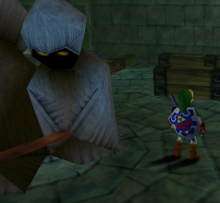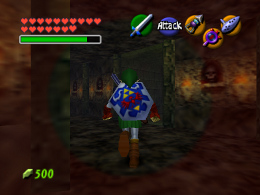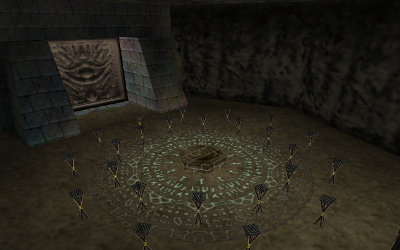The Forms of Fear in Zelda
Posted on October 26 2012 by Legacy Staff
 Happy Halloween! It’s that time of year again; children dress as goblins, ghouls or zombies, and go door to door requesting tricks or treats (but only ever get treats); and adults throw on the nearest article of rarely-worn clothing and make up some kind of costume for the party they’ll be attending. It’s also that time of year when we all consider things that we fear. In the spirit of the season, today we’ll be talking about fear in the Legend of Zelda series.
Happy Halloween! It’s that time of year again; children dress as goblins, ghouls or zombies, and go door to door requesting tricks or treats (but only ever get treats); and adults throw on the nearest article of rarely-worn clothing and make up some kind of costume for the party they’ll be attending. It’s also that time of year when we all consider things that we fear. In the spirit of the season, today we’ll be talking about fear in the Legend of Zelda series.
Fear is often called the strongest emotion. More than any other emotion, it brings on strong responses both psychological and physiological. But like every other emotion, what produces a fear response in one person will vary wildly from what produces a fear response from another person. As such, simply defining something as “scary” can be very difficult. Fortunately, there are ways to break down the idea of “scary” into more manageable definitions.
Horror novelist Stephen King, one of the most well known modern authors, describes fear in three categories in his book, Danse Macabre. The three categories — terror, horror, and revulsion — each define a different type of fear reaction. We’re going to look at each of these categories and their representation within the series, as well as King’s theory of effective horror.
Terror
Terror, according to King, is the highest form of fear. Primarily concerned with tension rather than release, terror is the slow build up that comes before a creature jumps out. It is an inactive form of fear, arising from the lack of action (the lack of anything happening), and thus benefits from longer durations, as the longer the tension builds without being released, the more intense the emotional response.
 One of the best mainstream examples of terror can be seen in the found footage horror genre. Films like Paranormal Activity, with static home video cameras set up in a house, often have long stretches with little action on screen. But the unnatural silence creates tension and expectation of something waiting to happen. However, more than horror or revulsion, terror can be found well outside the confines of horror films and horror games too. For one of the best examples in gaming, one need only look to Luigi’s Mansion: As Luigi walks down the hallways, the gentle crescendos of the music and increasing panic in Luigi’s whistling builds a palpable tension. Though the ultimate payoff is little more than a “Boo!” from a brilliantly colored ghost, the tension that precedes that appearance is enough to incite fear in the player.
One of the best mainstream examples of terror can be seen in the found footage horror genre. Films like Paranormal Activity, with static home video cameras set up in a house, often have long stretches with little action on screen. But the unnatural silence creates tension and expectation of something waiting to happen. However, more than horror or revulsion, terror can be found well outside the confines of horror films and horror games too. For one of the best examples in gaming, one need only look to Luigi’s Mansion: As Luigi walks down the hallways, the gentle crescendos of the music and increasing panic in Luigi’s whistling builds a palpable tension. Though the ultimate payoff is little more than a “Boo!” from a brilliantly colored ghost, the tension that precedes that appearance is enough to incite fear in the player.
In the Zelda series, terror is perhaps the most common form of fear. Most every entry in the series has at least one dungeon with a theme involving death: the Shadow Temple and Forest Temple in Ocarina of Time, the Earth Temple in Wind Waker, the Arbiter’s Grounds in Twilight Princess, the bottom of the Ancient Cistern in Skyward Sword, and to a lesser extent, the Stone Tower Temple from Majora’s Mask (though the tension that pervades the game due to the impending collapse of the Moon is pretty terrifying in its own right). All involve some sort of lingering spirits that lend a certain anxiety to the surroundings. Particularly in the Shadow Temple — the background music and grotesque statues and torture devices in the environment convey a strong sense of dread. While not frightening in its own right, the environment serves to amplify the anticipation of violent action that the enemies themselves pose, and as such build tension even as the player walks through the dungeons’ halls. Equally, the creatures that inhabit these and other areas in the games (Poes, Wallmasters, ReDeads, and Gibdos most commonly, but a large variety of unique undead enemies can add some variation) can create tension on a smaller scale. In the case of Poes and Wallmasters, the tension stems from the anticipation of one appearing. In the case of ReDeads and Gibdos, the nearby threat music kicks in well before you are within their scream radius, which immediately sets you on guard, building tension as you approach.
In all of these cases, the series provides us with a very distinctive payoff. That payoff, usually referred to as a jump scare, is what triggers the horror reaction.
Horror
 Horror is, most simply, a jump scare. It’s the fear that arises from the sudden shock caused by the release of tension established by the terror reaction. More simply, it is the moment when you finally see the monster in question. It is an active form of fear, as it involves action rather than inaction; terror is the expectation of action, and horror is the action itself. Since horror is the release of the tension, it would stand to reason that the horror response will be greater in the case of a longer build up of tension. However, in practice, this is not true. In most every case, horror will elicit a stronger reaction when it is sudden, without much build up. The trade-off is that it does not last longer than the extent of the shock. After that, the horror response ends. Note that there are two key parts to horror: the horror action, which is the jump scare or reveal of the creature itself, and the horror reaction, which is the audience’s response to the action.
Horror is, most simply, a jump scare. It’s the fear that arises from the sudden shock caused by the release of tension established by the terror reaction. More simply, it is the moment when you finally see the monster in question. It is an active form of fear, as it involves action rather than inaction; terror is the expectation of action, and horror is the action itself. Since horror is the release of the tension, it would stand to reason that the horror response will be greater in the case of a longer build up of tension. However, in practice, this is not true. In most every case, horror will elicit a stronger reaction when it is sudden, without much build up. The trade-off is that it does not last longer than the extent of the shock. After that, the horror response ends. Note that there are two key parts to horror: the horror action, which is the jump scare or reveal of the creature itself, and the horror reaction, which is the audience’s response to the action.
Notably, a horror response does not necessarily have to be caused by a terrifying object or occurrence: It is solely dependent upon the suddenness of the object or occurrence. Although the horror response triggered by the appearance of a knife-wielding maniac in any number of slasher films is typically a strong one, an equally strong horror response can come from the sudden, loud scare chord played in the film Scream whenever a character appears suddenly, even if the character in question is wholly innocent. Continuing the Luigi’s Mansion example from earlier, after a few moments of walking through a hall, suddenly a pink, bulbous ghost appears and shouts “Boo!”, which frightens Luigi and the player, if only for a second.
Though sudden jump scares are fairly rare in the Zelda series, the previously mentioned creatures cause clear horror reactions. Poes create horror when they suddenly spin into existence (or, in the case of The Wind Waker’s Poes, fade into visibility and moan at Link). Wallmasters create horror when they fall to the floor with a thud and skitter around (or, once again in the case of The Wind Waker’s Wallmasters, when they lunge at Link and create the screeching noise). ReDeads and Gibdos create horror when Link gets too close and they emit a sudden, ear-piercing scream, and freeze him in place. Each horror reaction is different in terms of severity, due mostly to the duration of the action. The spinning motion/moan of a Poe takes almost a full second, briefly announcing itself before becoming fully visible, and as such it is not as shocking. The thud of the Wallmaster is not particularly loud, and thus lacks a certain imposing quality. The ReDead and Gibdo shriek, however, is considerably louder than most other game sounds, and starts out very high pitched before gradually fading. The sudden high pitched shriek and subsequent paralysis proves to be one of the most enduring moments of horror in the entire series due to the impact of the sound and the immediacy.
Though the horror reactions in these examples are all the same, they differ in what reaction follows. In the case of Luigi’s Mansion, relief of tension follows the horror. In the slasher film cases, however, the killer itself, wearing a hockey mask or a glove with knives for fingers, creates the third type of fear reaction: revulsion.
Revulsion
 King calls revulsion the lowest form of fear, a position that is understandable given that while horror and terror require that a certain mood be established, revulsion depends only on a grotesque or disgusting sight. It is, in King’s words, “the gross-out scare”. Like terror, it is an inactive form of fear, as it requires no action; simply the presence of a revolting sight. Unlike terror and horror, it is unaffected by duration, provided that it is present long enough for the audience to get a good look at the object or creature in question.
King calls revulsion the lowest form of fear, a position that is understandable given that while horror and terror require that a certain mood be established, revulsion depends only on a grotesque or disgusting sight. It is, in King’s words, “the gross-out scare”. Like terror, it is an inactive form of fear, as it requires no action; simply the presence of a revolting sight. Unlike terror and horror, it is unaffected by duration, provided that it is present long enough for the audience to get a good look at the object or creature in question.
Revulsion is a very wide category that can encompass any number of images. Simply disgusting or sickening images easily fall into this category: Think films like Saw and Hostel that rely on mutilation of human bodies for scares, or films like Alien and its prequel Prometheus that rely on “body horror”, or mutation and disturbance of the human body in unnatural ways. In the previous example with the serial killer, though they are usually humanoid, oddities such as the hockey mask and blades for fingers make them grotesque, repulsive figures. But further than that, revulsion also includes creatures that fall into the “Uncanny Valley”, a robotics concept that states that the more a given robot looks like a human, the less people will be unnerved by its appearance, until it appears mostly — but not entirely — human, at which point people become highly unnerved by its appearance. More simply, if something looks human, but is just slightly off in a few ways (most commonly the eyes, as human eyes are the hardest to reproduce), people will be frightened of it. This concept extends to fictional creatures as well, and the fear that these creatures generate is a revulsion response.
Revulsion tends to be a bit rarer in the Zelda series primarily because the art style is rarely realistic enough to trigger a revulsion reaction. While creatures such as Dead Hand, Wallmasters and ReDeads do an admirable job creating this response, on the whole, creatures are designed to be intimidating rather than frightening. Boss monsters in particular are usually colossal and obviously non-human, avoiding the Uncanny Valley, and are rarely unnatural or disgusting enough to incite this response, with a few notable exceptions of course. The most significant examples of revulsion in the series, in my mind, come from Majora’s Mask. While the Moon’s human face creates a fairly strong revulsion response, nothing in the series has created as strong a response in me personally as the statues created when Link plays the Elegy of Emptiness, with or without the transformation masks. Rather than creating exact copies of Link, the statues all appear to have incredibly vacant expressions, and in the case of the Zora and Goron statues, their eyes have no pupils. Even outside their inclusion in the ever popular Jadusable alternate reality game, these statues are straight out of the Uncanny Valley, and if nothing else, they scared me silly when I first played the game.
Connections and Conclusion
The three forms are ordered in this way — terror, horror, then revulsion — for a reason. Though King ordered them this way primarily by his value in them, with terror being the most highly valued and revulsion being the most weakly valued, I would take that further, and say that these are ordered this way because it is a progression of fear responses. Terror is the inaction that precedes an action; something in the atmosphere makes you anticipate an action, and you begin to grow anxious. Horror is the action that you are anticipating, and once it happens, you experience a horror reaction, but the tension that was built in the terror reaction is released. That’s why the revulsion reaction exists: To keep you scared even after the monster has been shown and the tension has been released. Otherwise, the released tension would turn to relief, and the fear would vanish after the horror reaction.
Zelda does a pretty good job maintaining this flow of fear, particularly with its creature design. ReDeads, Wallmasters, and the Dead Hand in particular all have three definable stages, one for each fear reaction, that take no more than ten seconds in execution. The series also manages to play with the flow a little bit — as mentioned previously, some of the dungeons in the series do a good job creating tension, but in most cases have no definable horror reaction — and thus, the tension lingers throughout the dungeon, only relenting when the player completes it. Denying the player this sense of relief in the form of a horror reaction keeps them on edge effectively throughout the entire dungeon.
Could Zelda be scarier? Absolutely. But being scary isn’t the goal of the series. At most, Zelda manages to create an uneasy, creepy vibe; a weaker fear reaction that feels at home in its medieval fantasy trappings, rather than an intense fear reaction as one would see in a horror game such as Amnesia or Slender. There’s no pervasive sense of fear, but there isn’t supposed to be. It lends a sense of uniqueness to the dungeons that create such reactions, and they are all the more interesting because of it.




